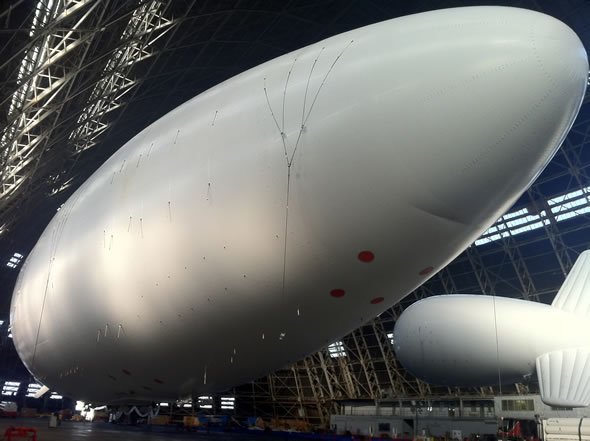
The 370-foot-long (123 m’), 1.4 million-cubic-foot (37,000 m3) blimp called ‘Blue devil 2’ is taking shape at a hangar in Elizabeth City, North Carolina. As the giant airship is being filled with helium, thus lighter than air, it becomes afloat inside the hangar. Once mission equipment is installed, the airship will begin its voyage to Afghanistan, where it will provide an unmanned platform for persistent surveillance and communications support assisting the ground forces. MAV-6 is the prime contractor for the $211 million ‘Blue devil 2’ program. (Wired Danger Room)

Blue Devil 2 is designed to support continuous missions of up to 216 hours (nine days) operating at an altitude of 20,000 ft, from where the airship, equipped with multiple ISR payloads, will covering an area of 36 square miles at a time, compared with about 16 square miles currently covered by ‘wide area airborne surveillance’ (WAAS) assets. Nine days is the maximum endurance achieved in optimal operating conditions. The actual mission endurance will be determined by environmental conditions in Afghanistan, including payload weight, winds, temperature, barometric pressure etc., The blimp is equipped with two ducted propellers and a rear maneuvering engine, all powered by a main diesel generator driving 120 KVA for propulsion and on board systems. The side motors are producing thrust for forward propulsion at a maximum airspeed of 90 knots, or offset wind effect; the rear motor is used to steering airship to maintain the required heading.
The blimp will be equipped with gondola shaped mission modules to be tailored for specific mission. The gondola has multiple attachments for 10- 40 sensors, including electro optical sensots (including wide area airborne surveillance multi-sensor, multi-spectral payloads), high definition motion video cameras, Synthetic Aperture Radar (SAR), Ground Moving Target Indication (GMTI) radar, communications systems, datalinks and high power supercomputer platform providing image processing, storage, retrieval and dissemination. On board processing will enable the Blue Devil 2 to retain the highest resolution and most detailed imagery without increasing total bandwidth consumption. In addition to storing data on board, the systems will be able to dump the entire imagery to the intelligence control hub, via wideband datalink. Other users will be able to obtain live imagery or past images for forensic analysis) on demand straight from the blimp, within 15 seconds, served via existing Rover or tactical networking. Different gondolas can be integrated into the Blue devil 2 platform in less than four hours.
The giant blimp will be able to remain on a mission for five days, with a gondola weighing 2,500 lb. (1.134 ton). Increasing the payload weight to 7,500 lb. (3.4 ton) will reduce mission endurance to three days.
An on-board supercomputer will gather, process and store the images collected and disseminate them to users on demand.
In paralel to the Air Forces’ Blue Devil 2 program, the U.S. Army is also planing to deploy an airship to Afghanistan, employing the British Hybrid Air vehicle design for the Northrop Grumman Long-Endurance Multi-intelligence Vehicle (LEMV) system. With a budget of $517 million LEMV is expected to cost twice as the MAV-6, but also offer a more versatile platform offering mission endurance of 21 days, complete runway independence and significantly larger area of authority covering up to 2,000 miles radius ofaction.




















